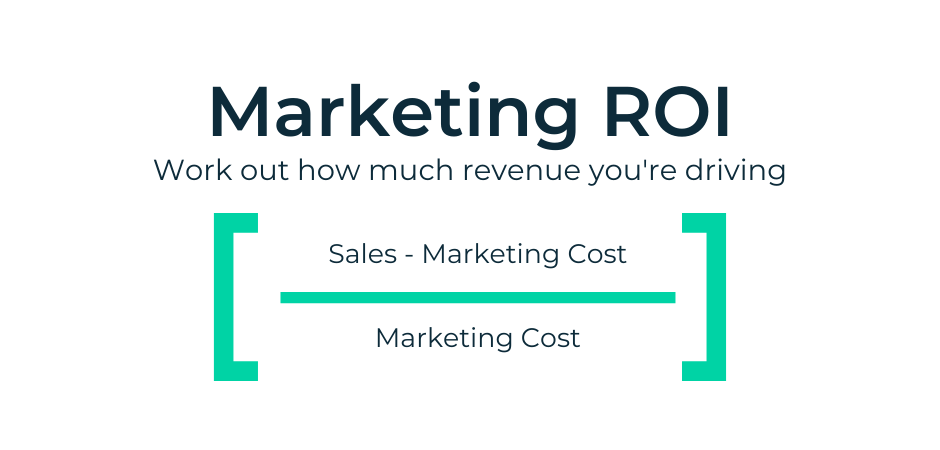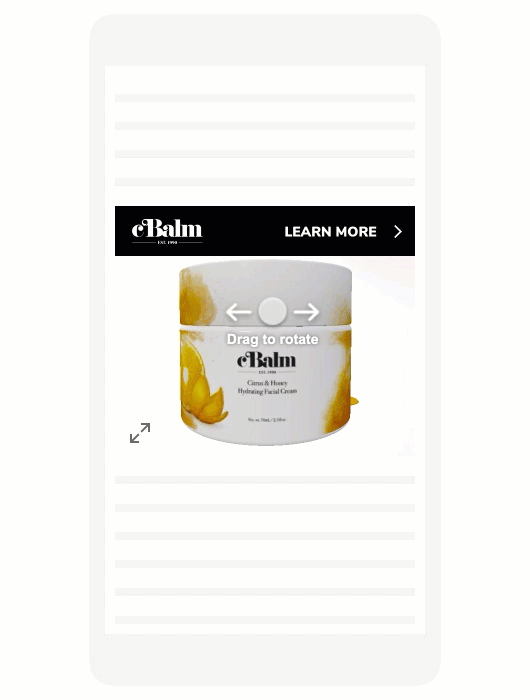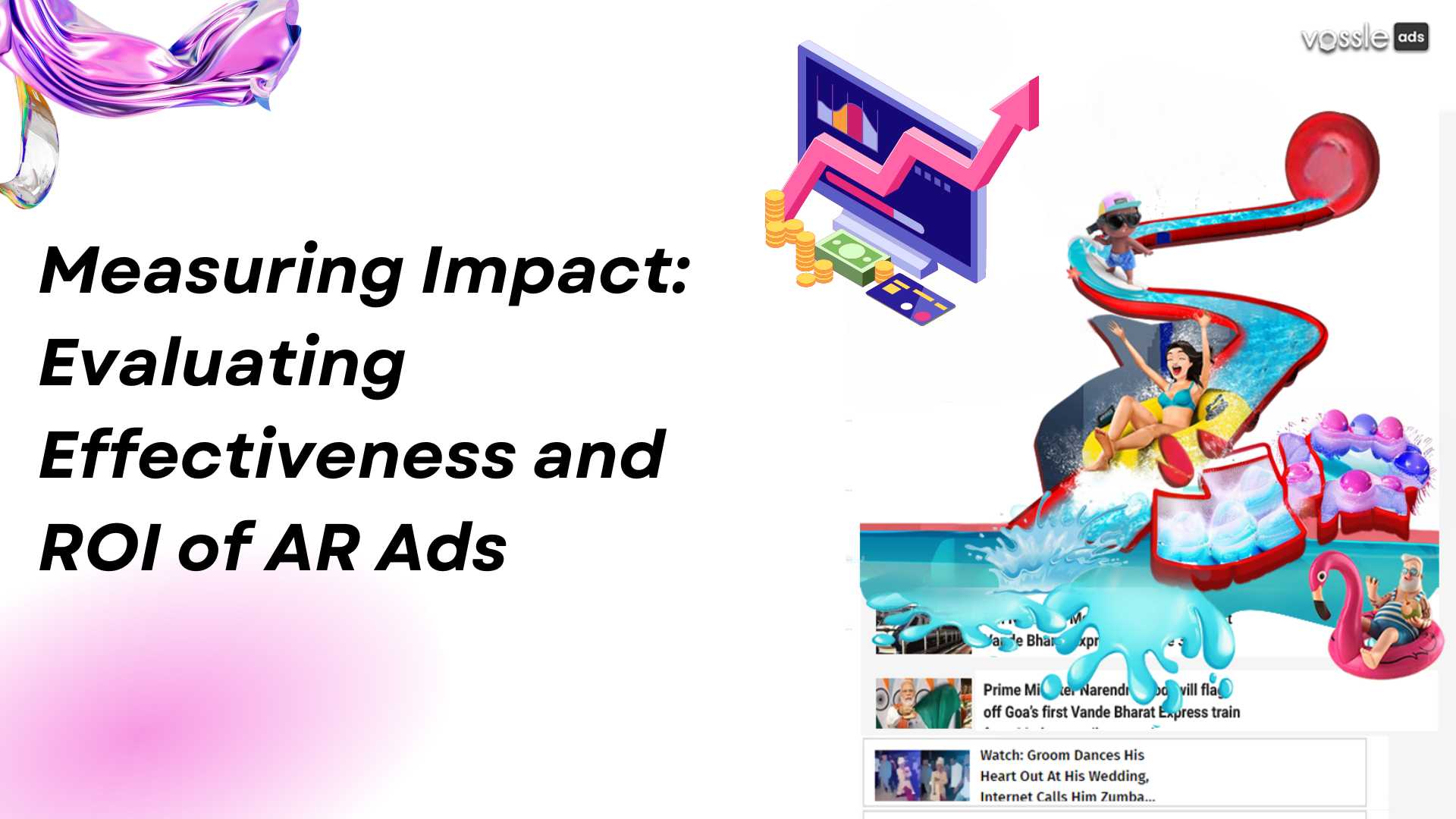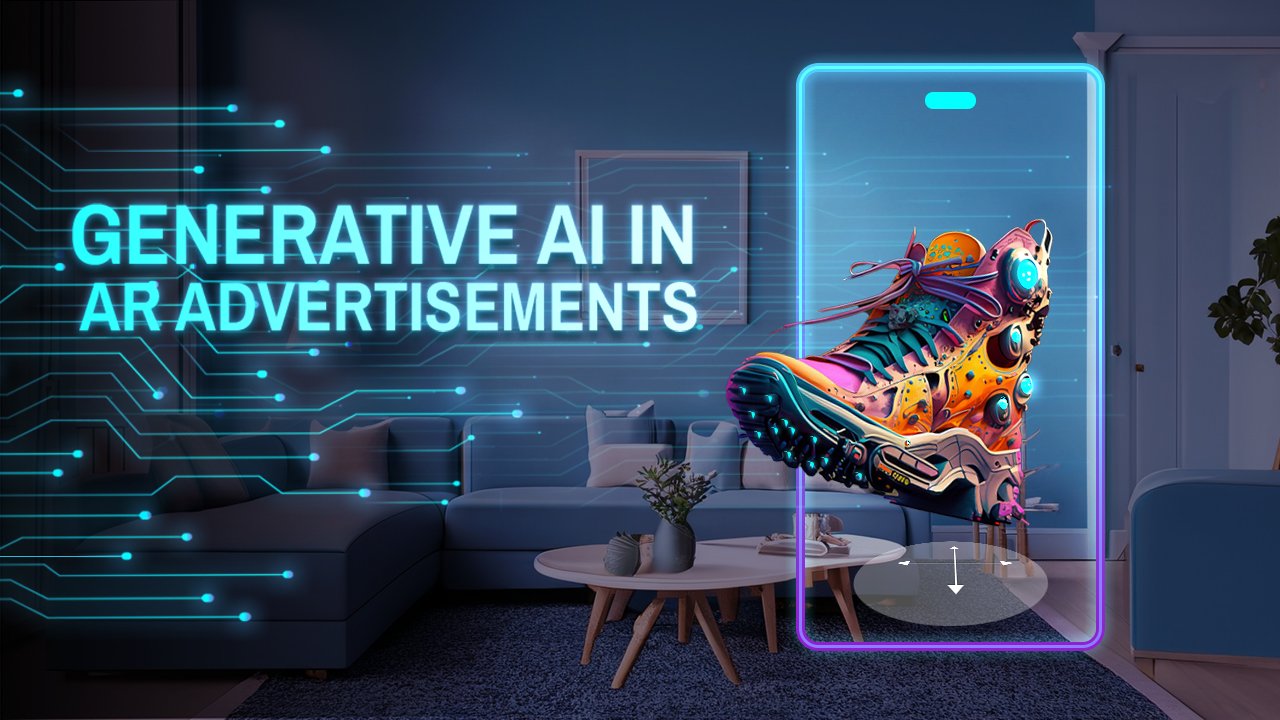The world is witnessing a great revolution in the form of immersive technologies. These technologies have the power to create an alternate reality and bring unprecedented experiences like Augmented Reality Ads that make the impossible possible.
These immersive technologies give users the freedom to go beyond physical laws, materialize their creativity, spice up their existing monotonous physical reality, and much more.
That is why an increasing number of people are fond of these immersive technologies and choose brands that engage with them using immersive technologies. Hence, gone are the days when the brand engagement was two-dimensional and non-interactive with little to no immersiveness.
Users want to be actively engaged with the brand and be part of their brand awareness campaign. They expect an active interaction with the brand and not passive content feeding.
And therefore, it is imperative for the brands to resonate with changing users’ values and include immersive experiences as part of their brand awareness and user engagement efforts.
The battle for consumer attention and engagement is fierce and traditional advertising methods are strictly a no-go.
On the contrary, the advent of Augmented Reality (AR) advertising has opened up a new realm of possibilities for brands seeking to break through the noise and create meaningful connections with their target audience.
In this blog, we dive deep into the world of AR advertisement, exploring its myriad advantages and the critical importance of measuring effectiveness and return on investment (ROI).
Furthermore, we examine the benefits and limitations of Google Swirl, a leading immersive advertising format, and discover how Vossle, an innovative platform, overcomes these limitations to provide unparalleled AR ad experiences.
Stay tuned to unlock the secrets of AR advertising success!
Understanding the Importance of Measuring Ad Effectiveness
Advertising effectiveness is the ability of an advertising campaign to generate the results intended by the business. An effective ad contributes to the business’s long and short-term goals.
Measuring the effectiveness of advertisements helps advertisers accurately assess the impact of their advertisements, spot shortcoming, and make data-based decisions to optimize their campaigns. It provides answers to some very important questions that help businesses know what works for them and what does not. Such as:
- Is the advertisement attaining the intended outcomes, such as introducing a brand or product, enhancing brand awareness, sharing information, etc?
- Is the advertisement reaching the right audience?
- Does the audience like the advertisement?
- Is it driving consumers to take action?
- What is the best marketing media mix working for us?
- How to manage ad spending levels, and bring in the best ROI possible?
Gaining such timely and regular insights on their ad performance helps businesses in more than one way. It helps you send the right message to the right audience, raise brand awareness efficiently, attract more audience, and extend the most powerful pitch for users to take action. It enhances your overall campaign to boost your business growth and outsmart the competition.
Moving further, considering the tough times wherein the marketing budgets are shrinking across the spectrum, the ROI component of the advertisement has gained more importance than ever. Attaining the best ROI is the only way and way to get the best out of the advertisement investment by deploying the best marketing strategy. Let’s discuss this aspect of advertising in a little more detail.
Marketing ROI and The Importance Of Measuring It

Return on Investment, or ROI, is a measurement metric that evaluates the effectiveness and profitability of marketing efforts. For this, the ROI compares the return generated from the money invested in marketing campaigns and activities.
This helps businesses assess the success of their marketing initiatives, optimize strategies, and allocate resources more efficiently.
A negative ROI indicates that the revenue generated from the campaign did not cover the cost of investment, resulting in a loss. The company should reevaluate its marketing strategies, campaign execution, or target audience to improve the ROI.
On the other hand, a positive ROI would indicate that the campaign generated more revenue than the investment, resulting in a profit. A higher ROI indicates better marketing performance, demonstrating that the marketing efforts are effective and yield profitable results.
It’s important to note that marketing ROI calculations can be more complex depending on the specific objectives, costs, and revenue attribution models used. However, the underlying principle remains the same, investments vs returns.
Measuring Return on Investment (ROI) is Important for Several Reasons
The first and foremost reason is that it allows businesses to determine the value and effectiveness of their advertising investments. First, it quantifies the marketing efforts to give the advertisers easily understandable and workable insights. They can assess whether the money spent on advertising is generating a positive return or do they need to make some changes.
The tangible metric also helps them spot which advertising campaigns, channels, or strategies are yielding the best results and optimize their resource allocation by investing more in high-performing campaigns and reallocating resources from underperforming ones. Therefore, the data-driven approach maximizes the efficiency and effectiveness of marketing efforts.
Also, they can identify trends, patterns, and opportunities for improvement. This ensures that their marketing strategies and tactics are aligned with business goals, with way more chances of success than any other metric.
Another crucial reason for measuring marketing success with the ROI metric is to establish accountability to foster trust and confidence in marketing strategies and their ability to drive business growth.
To explain, ROI provides a concrete way for businesses to demonstrate accountability to stakeholders, such as investors, executives, and shareholders. By presenting ROI data, businesses can showcase the impact of marketing activities on the bottom line and justify the effectiveness of advertising investments.
Measuring the effectiveness and return on investment (ROI) of advertisements is crucial for businesses to optimize their marketing strategies and allocate resources wisely. By evaluating the impact of advertisements, businesses can determine which campaigns are generating the desired outcomes and adjust their tactics accordingly.
Over time, the evolution of ad metrics has led to more sophisticated measurement techniques, considering factors like viewability, engagement, and attribution across various channels.
In this landscape, Augmented Reality (AR) advertisements fit best by offering immersive and interactive experiences that captivate audiences and drive engagement.
AR ads provide a unique opportunity to track user interactions, gather valuable data, and deliver personalized experiences, contributing to a more accurate assessment of effectiveness and ROI.
By embracing AR advertisements within the framework of measuring effectiveness and ROI, businesses can gain deeper insights into their marketing efforts and make informed decisions to achieve optimal results. The next segment is for you to understand this next evolutionary phase in advertising – AR advertisements.
Augmented Reality Ads – The Only Tool You Need to Stay Ahead
Augmented Realty Ads use Augmented Reality to create immersive advertisements. Immersive means that these ads engross users in the advertising content by overlaying digital 3D models onto users’ real-world environments. They are also knowns as AR advertisements or, simply, Augmented Reality ads.
Additionally, these digital elements are interactive so users can touch and manipulate the digital 3D as if they are right there in the real world. This involves users more actively in the advertisement and creates an unforgettable brand engagement experience.
In the ever-evolving landscape of digital advertising, Augmented Reality Ads have emerged as a revolutionary tool especially when powered with Artificial intelligence. The immersive and interactive experience blurs the line between the physical and digital worlds leading to higher attention-grabbing and driving engagement, not to forget the high-level personalization that AI brings. Since all these aspects are important for a successful business advertising effort, we will discuss these benefits along with many others in detail.
Immersive and Interactive Experience: Unique Brand Interaction
Augmented Reality ads transport users into a new dimension where brands come to life. These ads enable users to interact with products and experiences in ways never before possible i.e.by overlaying digital 3D models into the real world.
They spark curiosity by offering users virtual samples of products such as cosmetics to try virtually on them. Plus, users can always visualize products like furniture in their living rooms to better understand the product and make purchasing decisions faster.
Attention-Grabbing and Memorable: The Magic of Personalized AR-AI Ads
Augmented Reality ads have the power to cut through the noise of traditional advertising and captivate audiences. With AI, they gain the unique ability to offer personalized interactions on many levels. This way brands create memorable experiences that leave a lasting impression.
First, AI’s capability to scan huge amounts of data and make smart decisions means the advertisements are highly targeted taking into consideration users’ demography, interests, and buying behavior. This infuses personalization on the initial level i.e. before the blog has reached the user. This enhances the ad relevance for the user matching their likes and dislikes, preferences, and interests.
Secondly, during the ad campaign, AI optimizes advertising campaigns in real-time, based on performance data and user behavior. It continues to mold the ad campaigns as per user interaction with the advertisement and reach out in a way they respond in the most positive manner. For example, if the user is preferring the AR Tryon experience in the ad instead of just visualization, AI will bring that. Such continuous improvement leads to better results over time.
On top of it, AI also adds a more intelligent interaction by smartly identifying real-world objects to overlay with digital elements and features.
Lastly, AI tracks the KPIs of advertisement campaign and suggest changes for the future. These data-driven suggestions make advertisements highly impactful, influential, and effective.
Deeper Engagement and Stronger Brand Connection
Augmented Reality ads result in a deeper level of engagement by actively involving users in the ad experience. Whether it’s virtually trying on clothing, exploring 3D models, or playing gamified experiences, AR ads evoke emotions and create a sense of ownership. This heightened engagement translates into a stronger connection between the audience and the brand, leading to increased brand loyalty and advocacy.
Storytelling and Visualization
AR ads are a powerful way of brand storytelling. They help brands convey messages in a dynamic and visually captivating manner. By combining the physical environment with digital elements, brands can showcase their products and services in the right context, helping consumers visualize and understand their value. This immersive storytelling with AR ads deepens brand narratives and amplifies the impact of marketing campaigns.
Data-Driven Insights
Augmented Reality ads offer valuable data-driven insights into consumer behavior and preferences. By tracking interactions, dwell times, and user feedback, brands can gain a deeper understanding of their audience’s interests and needs. This data can then be leveraged to deliver better AR ad experiences that result in enhanced brand awareness, higher conversion rate, and positive brand image to individual users, enhancing relevance and driving higher engagement and conversion rates.
Assessing Effectiveness: Key Metrics for Augmented Reality Ads
As the popularity of Augmented Reality ads continues to rise, it becomes increasingly important for advertisers to understand and measure the effectiveness of their campaigns. In this regard, key metrics such as impressions, number of scans, dwell time, etc. play a vital role in evaluating the performance of Augmented Reality ads, providing valuable insights into audience reach, engagement, conversion rates, and more.
By harnessing these metrics, advertisers can optimize their strategies, enhance user experiences, and drive meaningful results. In this segment, we will explore some of the key metrics for measuring the impact of augmented reality ads and how they contribute to the success of advertising campaigns in these competitive times.
Impressions:
How many people saw your AR campaign? Impressions indicate the number of unique users who have been exposed to your AR ad. It measures the potential audience size and shows how many people have interacted with your ad in some way.
Opens/Scans:
This metric tells how many users scanned the QR code and entered the AR experience. A high number of Opens or Scans means the AR advertisement has been presented to the audience in the right manner.
Captures:
This indicator tells how many people took a photo or made a video using our AR experience after they have scanned the QR code to enter the experience. If a person enters the AR experience but does not make any photos or videos. It means the experience failed to kindle curiosity or impress the user, or it has not reached the right audience.
Depending upon the case, we need to change settings to target the right audience or we need to change or alter the experience. Thanks to Augmented Reality ads both of these options are easy as AR ads content can easily be altered to improve customer experience even when the campaign is live.
Engagement:
Engagement metrics focus on how users interact with your AR ad. This includes metrics such as the number of interactions (taps, swipes, gestures), time spent interacting, and the number of sessions. Higher engagement indicates that users are actively engaging with your ad content.
With the help of engagement metrics, advertisers can gauge the level of interest and involvement of their target audience. This information helps optimize campaigns by identifying elements that resonate most with users and enhancing those aspects to improve engagement.
Sharing and Virality:
This metric shows how many people shared the campaign with their followers, and how many times. It reflects how entertaining people found the AR experience. If they really like it they would readily share it on social media platforms and through direct messages, or by simply forwarding the AR ad to others.
This works really great in favor of the campaign as word-of-mouth marketing makes the experience go viral and amplifies its reach and impact. The higher the sharing and virality metrics, the broader the reach of your ad campaign.
Conversion Rate:
The conversion rate measures the percentage of users who complete a desired action after interacting with your AR ad. This action could be making a purchase, signing up for a newsletter, or downloading an app. It helps determine the effectiveness of your ad in driving desired outcomes.
Click-through Rate (CTR):
CTR measures the percentage of users who click on a specific call-to-action or link within your AR ad. It indicates how effective your ad is in driving users to take the next step and visit a website, download an app, or view more information.
By tracking conversion rates, click-through rates, and other relevant metrics, advertisers can identify the effectiveness of their call-to-action buttons, landing pages, or other conversion points within the AR experience. This insight enables them to make data-driven optimizations to increase conversions, such as adjusting the placement or design of the call-to-action, optimizing the user flow, or refining the messaging.
Engagement Rate:
It shows how much percentage of people have actively engaged with the campaign in any way, including likes, shares, and comments on social media. AR ads have been shown to enhance engagement rate by 8x when compared to non-AR benchmarks.
Dwell Time:
This metric considers the duration of time users spent interacting with the AR ad experience. The longer they interact with the brand the better connected they feel with the brand and more chances to convert them into regular users who also advocate for the brand.
Unique Users/Return Users:
Another important metric is to track and differentiate between unique and returning users. This helps understand how effective the AR ad campaign is in attracting new customers and retaining the existing ones.
It is important for advertisers to know whether the AR campaign is able to attract users who had no previous interaction with the brand. Further, it tells whether the AR ad is motivating people to revisit your brand.
These markers are important for businesses to track and broaden their audience.
Return on Investment (ROI):
We have already discussed this metric in the above sections and we know how critical it is. Still, to cover it in a nutshell, ROI is a critical metric that evaluates the financial impact of your AR ad campaign. It compares the cost of running the campaign with the revenue generated or the value achieved, such as increased brand awareness or customer acquisition. ROI helps determine the overall effectiveness and profitability of your AR ad campaign.
Tracking ROI, advertisers can make informed optimizations and maximize the effectiveness of their campaigns, increase engagement and conversions, and drive meaningful results. The ability to measure the impact of Augmented Reality ads, track conversions, and tie them back to business goals allows advertisers to evaluate the ROI of their AR ad campaigns accurately.
Google Swirl: A big leap in Immersive Advertisements but Still Falls Short

Google Swirl is an immersive display creative format designed for the mobile web. It allows businesses to offer 3D visualization to their audience and engage with them at deeper cognitive levels. Businesses can either showcase their product or tell brand stories using 3D visualization or any other creative way they can use 3D interaction between the user and the ad.
Google Swirl offers various benefits to businesses.
Business Can Show, Instead of Tell:
When it comes to delivering a compelling product visualization, Swirl’s 3D technology excels by allowing you to show rather than simply tell. It is particularly effective for campaigns that have a strong product focus or a visual story to tell. If your goal is to showcase specific features, colors, accessories, or any other visual elements, 3D can help bring them to life in a more engaging way.
For instance, by utilizing 3D, you can visually present the 3D models of a car and various customization choices available, allowing potential customers to see and interact with the different options.
Offers fresh perspective to customer
One of the significant advantages of employing 3D technology using Swirl is that it enables businesses to offer novel points of view and perspectives for better product visualization. By leveraging 3D, businesses can provide a more immersive experience for your audience, allowing them to explore product, its looks and dimensions, feature, its inner workings as well as the experience of using it. This can be particularly useful when trying to showcase scale, detail, or complex mechanisms.
For instance, if you want to demonstrate the components of a smartphone, using Swirl 3D enables users to interactively dive into the device, explore its internal structure, and gain a deeper understanding of its features.
Offer immersive brand engagement experiences
Incorporating 3D technology into your visual campaigns allows you to place your product at the center of the frame and show it within a relevant context. This helps enhance brand engagement by placing business messages within a cohesive brand universe. A luxury bag business can utilize 3D to display it within a premium environment, such as an elegant setting or alongside other high-end accessories, reinforcing its exclusivity and desirability.
By leveraging Swirl 3D, businesses can enhance product visualization, provide unique perspectives, and create immersive brand experiences that resonate with your audience and drive engagement.
However, there is one area the Google Swirls lack in, i.e. merging the brand’s digital world with users’ real world.
The Limitations of Google Swirl for Enhanced 3D-AR Ad Experiences: Vossle to Overcome
Google Swirl has been a prominent platform offering immersive visual experiences on the mobile web. However, it is not without its limitations. With the advent of Vossle, a cloud-based SAAS platform, businesses now have a better alternative to creating web-based AR experiences effortlessly. This essay explores the limitations of Google Swirl and demonstrates how Vossle overcomes these shortcomings, providing a more interactive and versatile solution.
Limited Platform Accessibility:
One of the significant limitations of Google Swirl is its confinement to the mobile web, restricting businesses to a specific platform. This limitation hampers the potential reach and engagement that businesses can achieve with their 3D campaigns.
Vossle, on the other hand, breaks free from this constraint by offering a cloud-based SAAS platform accessible across various devices and platforms, ensuring a wider audience reach and compatibility.
Geographical Limitations:
Google Swirl’s 3D ad experiences are limited to certain regions, posing a challenge for businesses looking to deploy their campaigns on a global scale. In contrast, Vossle empowers businesses to overcome this limitation.
With its cloud-based nature, Vossle allows ad experiences to be deployed globally, ensuring businesses can reach their target audience regardless of geographical boundaries. This expanded reach offers businesses greater opportunities to engage and connect with a diverse customer base.
Limited Interactivity:
Google Swirl’s 3D ad experiences offer limited interactivity options, often restricted to basic zooming and scrolling functionalities. However, Vossle sets itself apart by providing an advanced level of interactivity.
Combining both AR and 3D ads into a single platform, Vossle enables businesses to create highly interactive ad experiences. Users can engage with the ads through interactive elements, allowing them to explore, manipulate, and interact with the 3D models.
This elevated level of interactivity enhances user engagement and creates a more immersive advertising experience.
While Google Swirl has made strides in the realm of 3D visualization and immersive advertising, it faces limitations that hinder its full potential. Vossle emerges as a superior alternative, offering a cloud-based SAAS platform that overcomes these limitations.
With its broader platform accessibility, global deployment capabilities, advanced interactivity, and user-friendly interface, Vossle empowers businesses to create highly engaging and interactive 3D-AR ad experiences.
By embracing Vossle, businesses can unlock the full potential of 3D and AR advertising, captivating their audiences and elevating their brand presence in the digital landscape.
In the next section, we will discuss Vossle’s additional benefits that make it stand out from all the other AR advertising platforms.
The Added Advantages of Vossle
In addition to overcoming the limitations of Google Swirl, Vossle offers numerous advantages for both advertisers and publishers in the realm of AR/3D ad experiences. With its user-friendly platform and an increasing number of publishers collaborating, Vossle empowers advertisers to take control of their ad campaigns while providing publishers with enhanced website analytics and monetization opportunities.
Easy to Use
Before the introduction of Vossle, creating 3D and AR advertising experiences required technical expertise, coding knowledge, and the use of specific software. This created a barrier for businesses that lacked the necessary resources or technical skills.
Vossle revolutionizes the process by providing an intuitive, user-friendly interface that requires no coding or application downloads. With just a few clicks, users can select their desired experience, upload their 3D models, and fill in the relevant details.
This simplicity and accessibility democratize the creation of 3D-AR ad experiences, empowering businesses of all sizes to leverage this powerful technology.
Enhanced Website Analytics for Publishers
Vossle not only benefits advertisers but also provides advantages for publishers who choose to activate AR/3D ad units on their websites.
By incorporating these immersive ads, publishers can significantly enhance their website analytics, including metrics such as website traffic, user engagement, and overall user experience.
This added dimension of interactivity and visual appeal offered by AR/3D ads enhances user engagement and captivates visitors for longer durations, resulting in improved website metrics and a more satisfying user experience.
Higher Clickthrough Rates (CTRs)
One of the key benefits that publishers gain from incorporating AR/3D ads through Vossle is the higher clickthrough rates (CTRs) in their PPC ad campaigns. Immersive ads have proven to capture users’ attention and curiosity, leading to increased interaction and a higher likelihood of users clicking on the ads.
This heightened engagement translates into more income for publishers as advertisers experience higher CTRs and subsequently invest more in their ad campaigns.
Improved Cost Per Mille (CPM)
Immersive advertisements, particularly AR ads, offer a significantly higher level of engagement compared to traditional text ads. Studies have shown that AR ads are 90 times more engaging than text-based ads. This heightened engagement leads to improved viewership and increased demand for AR/3D ad experiences.
As a result, publishers can negotiate higher cost per mille (CPM) rates for these immersive ads, maximizing their revenue potential. The elevated CPM rates are a direct result of advertisers recognizing the value and impact of AR/3D ads, providing publishers with a lucrative opportunity to generate more income.
Better Audience Retention
AR/3D ads offer a unique advantage in terms of audience retention. Research indicates that memory encoding is 70% higher with AR experiences, highlighting the effectiveness of these immersive ads in capturing users’ attention and creating lasting impressions.
The playful interaction with digital elements in AR/3D ads keeps users engaged, as they explore and iterate to satisfy their curiosity while enjoying the interactive experience.
This increased audience retention not only benefits advertisers by conveying their brand messages more effectively but also provides publishers with an engaged and captivated audience, resulting in longer website sessions and increased monetization potential.
Advertiser Control and Multiple Publishing Options
Vossle disrupts the traditional dynamics of advertising campaigns by providing equal opportunities to both advertisers and publishers. Advertisers gain control through Vossle’s readily available AR platform, empowering them to create immersive ad experiences on their own terms.
Additionally, partnering with Vossle allows advertisers to choose from a growing list of publishers ready to publish their ads. This shift in power dynamics benefits both parties, enabling advertisers to select the most suitable publishing platforms while giving publishers access to high-quality, engaging AR/3D ads from a diverse pool of advertisers.
Conclusion
As technology continues to evolve, AR advertising has emerged as a game-changer in the marketing landscape. Its immersive experiences, enhanced product visualization, and personalized engagement capabilities make it a powerful tool for brands to connect with their target audience in meaningful ways. However, to fully harness the potential of AR advertising, measuring its effectiveness and ROI is crucial.
By tracking key performance indicators and analyzing user interactions, advertisers can gain valuable insights into campaign performance, audience engagement, and brand perception. This data-driven approach enables them to optimize their strategies, refine messaging, and allocate resources effectively, ultimately driving higher ROI and achieving their marketing goals.
While Google Swirl has played a significant role in bringing 3D visualization to mobile web platforms, it does come with limitations such as platform accessibility constraints and limited interactivity. This is where Vossle, an innovative AR platform, steps in to overcome these challenges. With its cloud-based SAAS solution, Vossle enables advertisers to create web-based AR experiences effortlessly, without the need for coding or downloading applications.
It offers an unparalleled level of interactivity and customization, combining both AR and 3D ads seamlessly. Furthermore, Vossle provides a growing network of publishers, allowing advertisers to reach a wider audience and amplify the impact of their AR campaigns.
AR advertising holds immense potential for brands looking to make a lasting impression on their customers. By leveraging its advantages, measuring effectiveness, and partnering with platforms like Vossle, advertisers can unlock the full power of AR, creating unforgettable experiences and driving tangible business results. Embrace the future of advertising and explore the endless possibilities that AR has to offer.
Vossle: Your Best Bet For AR Advertising, Hands Down!

Ready to take your advertising to new dimensions? Harness the power of AR with Vossle, the leading cloud-based SAAS platform for creating immersive web-based AR experiences. With our intuitive interface, you can create captivating AR ads in just a few clicks, reaching a global audience and maximizing your ROI. Don’t limit your advertising potential—unleash it with Vossle. Visit our website and embark on an AR revolution today!



















